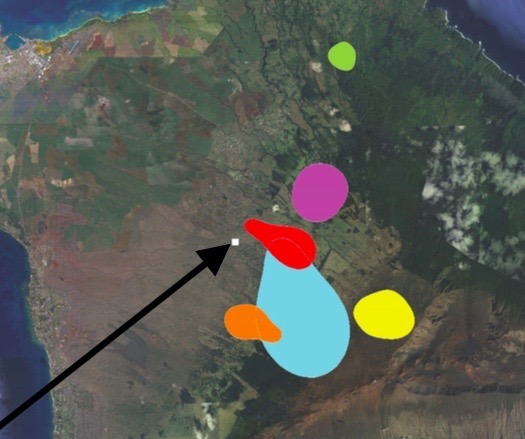
At the state Endangered Species Recovery Committee (ESRC) meeting last month, members debated the best way to mitigate the effects wind farms have on endangered Hawaiian hoary bats, which are being killed at a rate much higher than expected when the farms were originally permitted.
A few years ago, the committee developed a bat guidance document that included recommendations on how much wind farms should pay for mitigation and how large of an area mitigation actions should cover, among other things.
Without really knowing how to increase bat populations or to produce even a single bat, the committee decided that protecting or enhancing 40 acres of habitat for every bat death covered by an incidental take license or permit was a good place to start.
Since then, however, the U.S. Fish and Wildlife Service has decided that projects could commit to mitigation areas as small as 20.3 acres (see cover story).
But new research by H.T. Harvey & Associates of bats on Maui suggests that core use areas may be exponentially larger than both the ESRC’s and the FWS’s minimum standards, both of which were based on studies of bats on Hawai‘i island. And the areas used are often outside the forests, where most bat mitigation activities have focused.
The handful of bats tracked used grasslands, gulches, and low-density development areas mostly, and spent most of their time there foraging, they found.
They believe the bats frequent those habitats because their openness allows them to easily locate and catch prey, and because they’re also warm areas with a lot of flying insects.
The researchers tagged 16 bats, but were only able to track some of them. They found that the bats regularly foraged over a large area. They spent half their time on areas that, on average, were 2,967.5 acres.
One male consistently used a small, seven-acre hole in a gulch, where he scooped out what he needed, principal investigator David Johnston said at the Hawai‘i Conservation Conference in July. Another young male was all over the island, spending 50 percent of his time in an area spanning 16,000 acres, he said.
Because of the short battery life of the trackers, the study could not determine how the bats move across seasons. Johnston said he hopes new technologies will soon allow for year-round tracking.
“One hypothesis was bats would move upslope in the winter, like they’ve been observed on the Big Island. They didn’t do that. On any given night, it could go upslope and circle the crater, and come back the same night,” he said.

He continued that the size of the core use area, which has been so important in directing management and mitigation efforts, may actually be less important than the habitat quality and the available prey.
The Hawai‘i island studies upon which the minimum mitigation area sizes are based were conducted in largely native forest areas, whereas the Maui study areas were mostly disturbed, he said.
“Even with all those data, we cannot predict a given place and given time will have a higher level of [bat] activity. Why is that? … If you were to go at a time of year where you think there would be a lot of bat activity, it could be that a termite or beetle [they like to eat] chose not to go there,” he said.
At an ESRC meeting in January, Kristin Jonasson of H.T. Harvey said, “Bats don’t need pristine forest that is completely removed from humans. If we can get them the food resources, bats are effective in fragmented landscapes, a huge advantage that we have. We need to think about the ephemerality and abundance of insects, how they aren’t constant but occur in blooms, and the bats’ diets need to encompass a variety of insects that occur in different habitat types at different times of the year and different times of the night.”
“I can’t emphasize enough the importance of knowing what bats eat and where they eat it,” Johnston said at the January meeting adding that work is being done on analyzing the insects extracted from the bats’ guano.
Committee member Kawika Winter asked Johnston whether the bats showed any preference for native or non-native insects.
“We don’t have any data to address that yet. Chris Todd did his Master’s thesis on that, and it doesn’t look like bats have a preference. These species have evolved to eat certain groups of insects, and we may think this is simple, but they have very complex natural histories. Some moths can hear a hoary bat and they have a number of defenses. One is to fly away from the bat as soon as they hear the bat, and if the bat is very close, it will start flying erratically. Some moths produce sounds that can jam the bat’s sonar. You can probably predict, by family, which species or groups the bats are going to eat, as opposed to native or non-native,” he replied.
“What about termites?” Winter asked.
“Bats love termites,” Johnston said.
With regard to the bats’ roosting habits, Jonasson said that half of the bats tracked “roosted in people’s yards next to streets in fairly disturbed areas, and the other half roosted in forests or gulches that were inaccessible to us.”
Johnston added that the bats can’t roost in just any tree. “Often they like to roost in trees with clusters of leaves. But they’re looking for free space underneath them where they can take off. In a dense forest they may not be able to see,” he said.
— Teresa Dawson

Leave a Reply